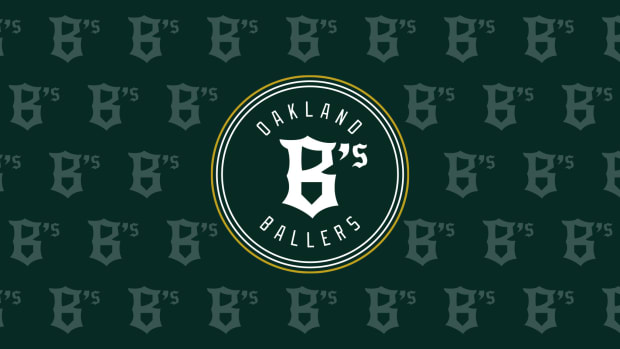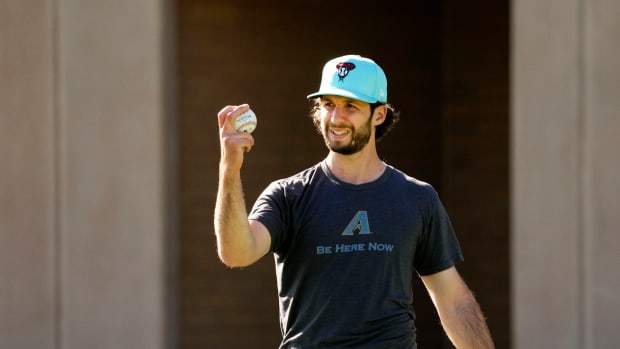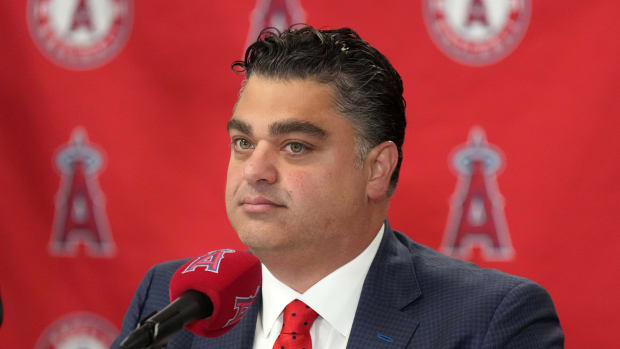The Free Agent Market Is Slow Partially Because It's Extremely Flawed
January is past its midpoint, and there's been no thaw in the free agent market. Just five of the top 20 free agents on The Reiter 50 have signed, namely Wade Davis (No. 6), Carlos Santana (No. 9), Jay Bruce (No. 11), Zack Cozart (No. 13) and Brandon Morrow (No. 18), with Bruce joining the list this week, albeit via a deal far short of the five years and $80-90 million he reportedly sought as of November. A few other players of note have recently inked as well—Addison Reed (No. 38), Howie Kendrick (No. 35) and Curtis Granderson (No. 43)—but the top tier is practically covered in icicles.
Last week at SI.com, Tom Verducci offered seven reasons for the market's slow pace. Earlier this week, Yahoo Sports' Jeff Passan took a deep dive into the possibility of collusion and the impact of the 2016 Collective Bargaining Agreement, in which the players received quality-of-life concessions but lost significant ground on economic issues. Along similar lines, SI contributor Joe Sheehan, in his subscription-only newsletter, recently wrote about the long-term impact of revenue sharing, noting, "There has never been a time in baseball history when a team—a team’s owner—got more money just for existing than it does today. The whole risk-reward scale has been skewed because of this … Revenue sharing has hurt competitive balance by guaranteeing profitability irrespective of on-field success."
This winter may be a point of inflection in the relationship between the players' union and owners. Or perhaps it's merely a perfect storm of factors slowing things down: The recent home run boom (which has flooded the market with power hitters, depressing their prices); agent Scott Boras' chokehold on this particular top tier (Jake Arrieta, Eric Hosmer, J.D. Martinez, Greg Holland and Mike Moustakas all rank among Reiter's top 14); the impact of the big-spending Dodgers and Yankees simultaneously trying to reset their luxury tax payments, while nearly a third of the league is rebuilding; and the bonanza of next winter's free agent crop offers (Bryce Harper! Manny Machado! Josh Donaldson! Maybe even Clayton Kershaw, if he opts out!). But to these eyes, two interconnected factors stand out, namely the prevalence of analytics in front offices and the apparent flaws of these particular players once the numbers are crunched.
In an industry that was upended by Moneyball 15 years ago, every front office has incorporated analytics into their decision making to some extent, and the past two World Series have each featured a pair of deeply stat-savvy teams. Whether they're relying upon their own proprietary metrics or using publicly available WAR, teams have no shortage of data on their own players and on the market of alternatives. They can estimate the values not just of their bats but also their baserunning and defense, not to mention the impact of pitching in front of a given defense. And if this scribe can apply research on aging curves, cost per win and salary inflation to illustrate the assumptions underlying the latest actual or potential contract, so can they.
All of us can see that players tend to reach free agency once they’ve passed their peaks, which in the post 1994-strike era are skewing even younger than the age 25-29 range previously accepted within the sabermetric community. Even in the first year of their new deals, free agents generally don't come close to replicating their previous year's production. Look back to The Reiter 50 from two years ago—David Price, Zack Greinke, Jason Heyward, Yoenis Cespedes, Justin Upton, Jordan Zimmermann, Chris Davis and Alex Gordon and Matt Wieters make up the top nine—for a harsh reminder.
Such knowledge has resonated throughout the industry. Rather than paying free agent-level prices, teams have put more playing time in the hands of younger players making salaries that are either a function of the league minimum or discounted via arbitration eligibility.
Analytics are particularly impactful when applied to what already scanned as a relatively weak crop of free agents. As I've illustrated in my What's He's Really Worth series, top free agents such as Hosmer, Martinez, Darvish, Arrieta and Cain almost uniformly seem to be dealing with recent performance regression and injuries. Consider this lightning-round rundown of Reiter's top 20 free agents, all of whom certainly have their virtues and can help a team win under the right conditions, but also have facets that could potential suitors pause. (All WAR figures refer to the Baseball-Reference version, and all intraposition rankings are among players with 1,000 plate appearances from 2015–17 and at least 50% of games played at the position unless otherwise indicated).
1. J.D. Martinez, RF
2018 age: 30
2015-17 WAR: 10.9 (5th of 26 RF)
Just one MLB season with more than 123 games (158 in 2015). Bad defensive metrics (-27 Defensive Runs Saved in 2016-17) suggest a future as a DH.
2. Yu Darvish, RHP
2018 age: 31
2015-17 WAR: 6.5 (45th among SP)
High mileage due to starting NPB career at age 18. Missed 2015 due to Tommy John surgery, made 30 starts just twice, battered in 2017 World Series due to pitch tipping issue.
3. Jake Arrieta, RHP
2018 age: 32
2015-17 WAR: 13.9 (7th among SP)
Back-to-back seasons of significant performance regression since winning 2015 NL Cy Young, reflected both in traditional and advanced stats, not to mention about two mph in lost fastball velocity.
4. Eric Hosmer, 1B
2018 age: 28
2015-17 WAR: 8.7 (8th of 25 1B)
Lacks traditional power profile of a first baseman. Advanced stats show drastic year-to-year inconsistency and defensive metrics far out of line with his four Gold Gloves.
The Pirates Could Have Been Contenders, but Ownership Cried Poverty and Betrayed Their Fans
5. Lorenzo Cain, CF
2018 age: 32
2015-17 WAR: 15.4 (3rd of 28 CF)
Missed over one-third of 2016 due to hamstring and wrist injuries. History of leg injuries. Among the oldest of this group.
6. Wade Davis, CL (signed 3 yr/$52M with Rockies)
2018 age: 32
2015-17 WAR: 7.1 (3rd among RP)
Back-to-back seasons of significant performance regression (rising walk rate and home run rate, ERA and FIP) since helping Royals win 2015 championship. Recurrent forearm strain limited him to 10 appearances over final two months of 2016.
7. Mike Moustakas, 3B
2018 age: 29
2015-17 WAR: 7.0 (15th of 25 3B)
Limited to 27 games by 2016 ACL tear. Only two full seasons with above-average production (OPS+ above 100) and only one with OBP above .314; career marks of 96 and .305, respectively. Sudden falloff defensively in 2017, with career lows in DRS (-8) and UZR (-3).
8. Jonathan Lucroy, C
2018 age: 32
2015-17 WAR: 5.4 (T-9th of 23 catchers)
Plummeted from 24 homers in 2016 to six in 2017 despite splitting season between hitter-friendly environments in Texas and Colorado. Dramatic falloff since MVP-caliber 2014 according to WAR (6.7 in 2014, 5.5 since) and Baseball Prospectus pitch framing metrics (+68 runs 2012-14, -13 since)
9. Carlos Santana, 1B (signed 3-yr/$60M with Phillies)
2018 age: 32
2015-17 WAR: 7.6 (10th of 25 1B)
Low batting average, modest offensive profile for a first baseman; his 113 OPS+ from 2015–17 tied for 13th out of 25 with at least 1,000 plate appearances over those three years.
10. Alex Cobb, RHP
2018 age: 30
2015-17 WAR: 1.6 (139th among SP)
Missed all of 2015 due to Tommy John surgery and posted an 8.59 ERA in five starts in 2016. His 17.3% strikeout rate (just 6.4 per nine) ranked 47th out of 58 pitchers who qualified for the ERA title.
11. Jay Bruce. RF (signed 3-yr/$39M with Mets)
2018 age: 31
2015-17 WAR: 4.2 (21st of 26 RF)
Worth just 0.2 WAR combined from 2014-16 due to combo of bad offense (98 OPS+) and defense (-14 DRS)
12. Lance Lynn, RHP
2018 age: 31
2015-17 WAR: 6.5 (T-45th among SP)
Missed all of 2016 due to Tommy John surgery, doesn't miss many bats; his 19.7% strikeout rate ranked 39th out of 58 ERA qualifiers in 2017.
13. Zack Cozart, SS (signed 3-yr $38M with Angels)
2018 age: 32
2015-17 WAR: 8.9 (10th of 26 SS)
Glove whiz who prior to last year's breakout (24 HR, 141 OPS+, 4.9 WAR) owned career 82 OPS+ and had only one season above 2.5 WAR. Injury prone, with just 122 games played in 2017 and 296 from ’15-17.
14. Greg Holland, CL
2018 age: 32
2015-17 WAR: 1.7 (T-108th among RP)
Missed late 2015 and all of ’16 due to Tommy John surgery. Posted 7.58 ERA and 2.4 HR/9 over final two months of 2017.
15. Carlos Gonzalez, RF
2018 age: 32
2015-17 WAR: 5.2 (12th of 26 RF)
Dreadful 2017 season (.262.339/.423/87 OPS+/-0.2 WAR) and majors' widest home/road splits during Rockies career (2009–17), including .253/.310/.434 in 2,238 PA away from Coors Field.
16. Logan Morrison, 1B
2018 age: 30
2015-17 WAR: 4.0 (17th of 25 1B)
Long injury history and subpar production for a first baseman prior to 2017 breakout (38 HR, 135 OPS+, 3.6 WAR). His 111 OPS+ from 2015-17 is tied for 16th out of 25 first basemen with at least 1,000 plate appearances over those three years.
17. Eduardo Nunez, Super UT
2018 age: 31
2015-17 WAR: 5.1 WAR (37th of 60 at 3B/2B)
Versatile, but defensive metrics at shortstop have been brutal (-44 DRS in 270 career games), and still bad elsewhere in the infield (-12 DRS in 303 games at 3B/SS). His 2016 season is only one with more than 114 games or 1.5 WAR.
18. Brandon Morrow, RP (signed 2-yr/$21M with Cubs)
2018 age: 33
2015-17 WAR: 2.5 (T-67th among RP)
Electrifying but oft-injured; hasn't thrown 50 major league innings in a season since 2013 and has averaged just 32 per year since then.
19. Melky Cabrera, LF
2018 age: 33
2015-17 WAR: 3.9 (14th of 20 LF)
Thanks to awful defense (-37 DRS), has averaged just 1.4 WAR in five seasons since his 2012 PED suspension, despite averaging 598 PA.
20. Todd Frazier, 3B
2018 age: 32
2015-17 WAR: 10.8 (9th of 25 3B)
Batting average on balls in play has fallen for three straight years, from .309 in 2014 to .226 in '17; OBP was below .310 in both 2015 and '16.
I could go on, but the point is that even when it comes to the best of this year's free agents, it’s not too hard to identify significant flaws. Of the seven pitchers, four had Tommy John surgery within the last three years, and all hit the disabled list at least once, with Arrieta the only one not to miss at least a month due to an arm injury. Of the 13 position players, just two will start the 2018 season still in their twenties. Only two rank among the top five at their positions in three-year WAR, while five were in the lower half of qualifiers. There isn’t an apple without a bruise in this bushel. Which isn’t to say that there aren’t some juicy-looking ones; Cain, Lynn and Frazier are particularly appealing given their skills and likely prices.
There’s much more to be said about the confluence of factors that are affecting this winter’s market, and the need for the players’ union to regain ground on the economic front or see its salaries depressed even further. There’s also plenty more to be said about the unintended consequences of these savvy front offices’ decisions, both on the field —where an emphasis on power hitting, power pitching and shorter stints for starts has resulted in a lack of in-play action—and off, where the converging strategies of cookie-cutter front offices have turned the hot stove into an abandoned popsicle stand. The intended consequences of those decisions, including the signing of so many top young players to long-term extensions to delay their free agencies, have thinned out this free agent market, too.
Part of the problem, however, has to be that few of these top free agents are true game-changers, marquee guys who will sell tickets and fuel championship dreams. That doesn’t mean they stink on ice or aren’t deserving of market-level salaries, but even in an industry awash in cash, we shouldn’t be too surprised that many are proving to be tough sells.



































